Instabilities, Crushing, and Shocks in Architected Materials
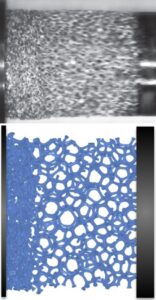
Lightweight architected materials such as foams and lattices have great potential in a variety of engineering applications owing to their unique mechanical, thermal and acoustic properties. In many cases and due to their excellent energy absorption characteristics, high strength-to-weight ratio and high temperature resistance, these material systems become excellent candidates in environments where extreme temperatures and stresses occur such as in transportation and space structures among others. The complex interplay of topology, material distribution and base material behavior in architected materials leads to a wide range of deformation mechanisms that include nonlinear elastic instabilities, plastic (yielding) deformation, fracture, and shock-type collapse under high loading rates. Our group combines experiments, modeling and theory to examine the large deformation behavior of lightweight architected materials in order to enable design methodologies past ad-hoc approaches and accelerate the discovery of new multifunctional materials systems with unprecedented properties.
Current projects include:
- Dynamic properties and Hugoniot curves for metallic architected materials under high velocity impacts
- Effect of high-temperatures on the crushing and energy absorption of foams
- Instabilities in elastomeric foams for the design of soft cellular materials with tailored properties
Mechanics of Architected Composites
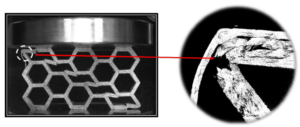
Inspired by natural architected materials that exhibit a hierarchical structure (e.g. bone, wood), there have been recent efforts to design novel structural systems with superior resilience that is derived by individual components that span many different length-scales. We are currently investigating the properties of architected cellular composites that harness the combination of topology at the macroscale with the programmable arrangement of continuous fibers at the strut level, in order to significantly enhance the global structural performance under a range of loading conditions. Our objective is to correlate processing parameters and microstructural characteristics to the nonlinear mechanics and failure of hierarchical cellular composite structures.
Current projects include:
- Additive manufacturing of cellular composites with varying topologies and fiber deposition patterns
- Nonlinear mechanics and failure of lightweight architected composites
Brittle Fracture in Cellular Materials
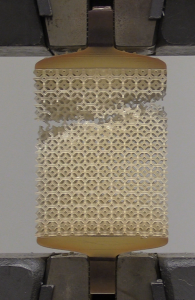
Fracture is a universal process driving the failure of many systems from large scale natural phenomena such as earthquakes, to the delamination of thin films used in microelectronic devices. In the case of lightweight brittle architected materials, which are essentially organized assemblies of thin structural members, fracture is intertwined with buckling and dynamic effects to produce a complex failure mechanism. Brittle cellular solids combine low weight with a large surface area and have thus found use in energy storage devices, filtration, acoustic insulation, armored textiles as well as thermal shielding under extreme conditions (e.g. Parker Solar Probe). Our recent efforts integrate additive manufacturing, characterization by microcomputed tomography, and physics-based multi-scale modeling, to understand and predict the onset and propagation of damage in brittle cellular materials. Our goal is the synthesis of novel architected materials that combine superior fracture strength and toughness.
Current projects include:
- Predicting fracture strength of three-dimensional (3D) lattices under tension and compression
- Crack propagation and fracture mechanics of cellular solids
Wave Propagation and Metamaterials
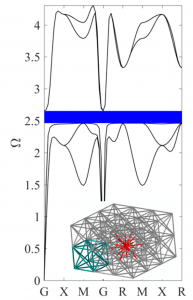
Phononic crystals are architected materials designed to control and manipulate the propagation of elastic/acoustic waves to derive properties unprecedented in traditional monolithic materials. In a phononic crystal the density and/or elastic properties of the structure vary, usually periodically, leading to the formation of band gaps, frequency ranges in which the propagation of waves within the material is prohibited. A large number of phononic crystals have been fabricated across a range of length scales with promising impact in vibration mitigation, sensing, acoustic processing, and ultrasound imaging. We are developing numerical models to examine elastic and acoustic wave propagation in 3D architected materials and incorporate them in rigorous algorithms for the design of metamaterials that use Bragg scattering to produce bandgaps at desired frequencies.
Current projects include:
- Wave directionality and bandgaps in 3D lattice materials
- Topologically optimized phononic materials
Design and Mechanical Properties of DNA Nanostructures
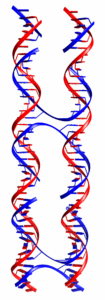
The programmed self-assembly of synthetic DNA strands offers the unique ability to synthesize complex architectures with precision at the nanoscale. These DNA nanostructures can act as templates for both organic and inorganic molecules thus having tremendous potential in a variety of applications ranging from drug delivery and cell mechanics to nano-manufacturing. Despite the exponentially increasing number of studies that focus on assembly conditions and design methodologies of DNA nanostructures, however, little is known about their mechanical properties. Over-engineering is usually employed to achieve desired robustness/stiffness, which in turn increases the complexity of the designed assemblies and limits both scalability and the yield of the synthesis process. Our group examines the mechanical properties of DNA nanostructures for the design of robust nanostructures that are able to withstand biophysical forces, such as shear and normal stresses generated in vivo, bending loads caused by attached nanoparticles through novel material synthesis at the nanoscale, as well as extend their use as biosensors for cell mechanics.
Current projects include:
- Examining the effect of nicked helices and crossovers on the stretching stiffness of DNA origami (collaboration with Prof. Y. Chen, Johns Hopkins University)
- Development of multi-scale computational models of DNA nanostructures


